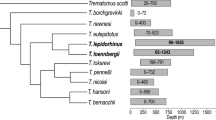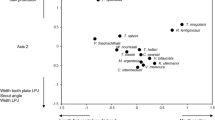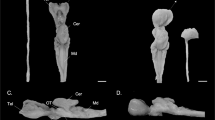Synopsis
Brain patterns are compared by quantitative histology in 28 native and introduced mid-European cyprinid species, considering 17 primary sensory and higher order brain areas. Cluster analysis (CLA) and principal component analysis (PCA) based on relative volumes of these brain areas indicate that cyprinid brains are diversified into four major groups, basic cyprinid, abramine, octavo-lateralis and chemosensory. PCA recognizes the brain of Phoxinus phoxinus as a fifth group. Interspecific differences in brain morphology are mainly caused by variability in relative sizes of the brain stem lobes for external and internal taste (lobus facialis and lobus vagus), as well as of octavo-lateralis and visual areas. Higher order brain areas show little interspecific variation in relative size, and were grouped by PCA according to inter- and intraspecific allometries. Hypotheses on brain functions are based on brain area correlations. We propose that the processing of external taste information in the valvula cerebelli may be particularly important for benthivorous cyprinids, whereas the integration of octavo-lateralis input with visual information via the torus longitudinalis-stratum marginale system may play a key role in the planktivores. Brain patterns suggest two major pathways of cyprinid evolutionary and ecological radiation, one leading from the basic cyprinids towards octavo-lateralis dominated midwater and surface planktivores, the second towards taste-dominated benthivores.
Similar content being viewed by others
References cited
Ariens Kappers, C.U., G.C. Huber & E.C. Crosby. 1936. The comparative anatomy of the nervous system of vertebrates, including man. Vol. 1–3. Macmillan, New York. 1350 pp.
Balon, E. 1968. Beitrag zur Systematik, Ökologie, Morphologie, Alter, Wachstum und Eizahl der Eier der Ziege [Pelecus cultratus (L.)] aus der Donau bei Medevedov. Biologické práce (Bratislava) 13: 63–88.
Balon, E.K., S.S. Crawford & A. Lelek. 1986. Fish communities of the upper Danube River (Germany, Austria) prior to the new Rhein-Main-Donau connection. Env. Biol. Fish. 15: 243–271.
Bauchot, R., M.L. Bauchot, R. Platel & J.M. Ridet. 1977. Brains of Hawaiian tropical fishes: brain size and evolution. Copeia 1977: 42–46.
Bauchot, R., J.M. Ridet & M.L. Bauchot. 1989. The brain organization of butterflyfishes. Env. Biol. Fish. 25: 205–219.
Blaxter, J.H.S. 1988. Sensory performance, behavior and ecology of fish. pp. 203–232. In: J. Atema, R.R. Fay, A.N. Popper & W.N. Tavolga (ed.) Sensory Biology of Aquatic Animals, Springer Verlag, New York.
Bleckmann, H. 1988. Prey identification and prey localization in surface-feeding fihs and fishing spiders. pp. 619–641. In: J. Atema, R.R. Fay, A.N. Popper & W.N. Tavolga (ed.) Sensory Biology of Aquatic Animals, Springer Verlag, New York.
Bock, W.J. 1980. The definition and recognition of biological adaptation. Amer. Zool. 20: 217–227.
Brabrand, A. 1985. Food of roach (Rutilus rutilus) and ide (Leuciscus idus): significance of diet shifts for interspecific competition in omnivorous fishes. Oecologia 66: 461–467.
Brandstätter, R. & K. Kotrschal. 1989. Life history of roach, Rutilus rutilus (Cyprinidae, Teleostei): a qualitative and quantitative study on the development of sensory brain areas. Brain, Behav. Evol. 34: 35–42.
Brandstätter, R. & K. Kotrschal. 1990. Brain growth patterns in four European cyprinid fish species (Cyprinidae, Teleostei): roach (Rutilus rutilus), bream (Abramis brama), common carp (Cyprinus carpio) and sabre carp (Pelecus cultratus). Brain, Behav. Evol. 35: 195–211.
Brosius, G. 1989. Spss/pc. Advanced statistics and tables. McGraw Hill, Hamburg. 350 pp.
Bullock, T.H. 1983. Why study fish brains? pp. 361–368. In: R.E. Davis & R.G. Northcut (ed.) Fish Neurobiology, The University of Michigan Press, Ann Arbor.
Davis, B.J. & R.J. Miller. 1967. Brain patterns in minnows of the genus Hybopsis in relation to their feeding habits. Copeia 1987: 1–39.
Davis, R.E. & R.G. Northcutt (ed.). 1983. Fish neurobiology. Vol. 2. The University of Michigan Press, Ann Arbor. 370 pp.
Echteler, S. 1985. Organization of central auditory pathways in a teleost fish, Cyprinus carpio. J. Comp. Physiol. A. 156: 267–280.
Evans, H.M. 1931. A comparative study of the brains in British cyprinoids in relation to their habits of feeding, with special reference to the anatomy of the medulla oblongata. Proc. R. Soc. Lond. B 108: 233–257.
Evans, H.M. 1932. Further observations on the medulla oblongata in cyprinoids; and a comparative study of the medulla of clupeoids and cyprinoids with special reference to the acoustic tubercles. Proc. R. Soc. Lond. B 111: 247–280.
Evans, H.M. 1935. The brain of Gadus, with special reference to the medulla oblongata and its variation according to feeding habits of different Gadidae-I. Proc. R. Soc. B. 117: 56–68.
Evans, H.M. 1940. Brain and body of fish. A study of brain pattern in relation to hunting and feeding in fish. Technical Press, London. 224 pp.
Evans, H.E. 1952. The correlation of brain patterns and feeding in four species of cyprinid fishes. J. Comp. Neurol. 97: 133–142.
Finger, T.E. 1978. Gustatory pathways in the bullhead catfish. II. Facial lobe connections. J. Comp. Neurol. 180: 691–706.
Finger, T.E. 1983a. The gustatory system in teleost fish. pp. 285–311. In: R.G. Northcutt & R.E. Davis (ed.) Fish Neurobiology, Vol. 1, The University of Michigan Press, Ann Arbor.
Finger, T.E. 1983b. Organization of the teleost cerebellum. pp. 261–284. In: R.G. Northcutt & R.E. Davis (ed.) Fish Neurobiology, Vol. 1, The University of Michigan Press, Ann Arbor.
Finger, T.E. 1987. Gustatory nuclei and pathways in the central nervous system. pp. 331–354. In: T.E. Finger & W.L. Silver (ed.) Neurobiology of Taste and Smell, J. Wiley Publishers, New York.
Finger, T.E. 1988. Organization of the chemosensory systems within the brains of bony fishes. pp. 339–363. In: J. Atema, R.R. Fay, A.N. Popper & W.N. Tavolga (ed.) Sensory Biology of Aquatic Animals, Springer Verlag, New York.
Geiger, W. 1956a. Quantitative Untersuchungen über das Gehirn der Knochenfische mit besonderer Berücksichtigung seines relativen Wachstums. I. Acta anat. 26: 121–163.
Geiger, W. 1956b. Quantitative Untersuchungen über das Gehirn der Knochenfische mit besonderer Berücksichtigung seines relativen Wachstums. II. Acta anat. 27: 324–350.
Goldschmid, A. & K. Kotrschal. 1989. Ecomorphology: developments and concepts. Progr. Zool. 35: 501–512.
Gomahr, A., M. Palzenberger & K. Kotrschal. 1992. Density and distribution of external taste buds in cyprinids. Env. Biol. Fish. 33: 125–134.
Haslett, J.R. 1989. Adult feeding by holometabolous insects: pollen and nectar as complementary nutrient sources for Rhingia campestris (Diptera: Syrphidae). Oecologia 81: 361–363.
Huber, R. & M.K. Rylander. 1992. Brain morphology and turbidity preference in Notropis and related genera (Cyprinidae, Teleostei). Env. Biol. Fish. 33: 153–165.
Herrick, C.J. 1905. The central gustatory paths in the brains of bony fishes. J. Comp. Neurol. Psychol. 15: 375–456.
Ito, H. & R. Kishida. 1978. Afferent and efferent fiber connections of the carp torus longitudinalis. J. Comp. Neurol. 181: 465–476.
Jolicoeur, P. & G. Baron. 1980. Brain center correlations among Chiroptera. Brain, Behav. Evol. 17: 419–431.
Junger, H. & K. Kotrschal. 1989. Developmental changes in the optic tracts of cyprinids (Cyprindae, Teleostei). p. 191. In: N. Elsner & W. Singer (ed.) Dynamics and Plasticity in Neuronal Systems, Proceedings of the 17th G\:ottingen Neurobiology Conference, Georg Thieme Verlag, Stuttgart.
Kaiser, H.F. 1974. An index of factorial simplicity. Psychometrica 39: 31–36.
Khanna, S.S. & H.R. Singh. 1966. Morphology of the teleostean brain in relation to feeding habits. Proc. Nat. Acad. Sci. India 336: 306–316.
Kirka, A. 1963a. Brain structures in the Danube representatives of perciformes and the role of brain study for the systematic and ecology of fishes. Zool. Zhurnal 42: 400–407 (in Russian).
Kirka, A. 1963b. Die äuβere Gehirnform des Donaunerflings (Rutilus pigus virgo He.) und ein Vergleich seines Gehirns mit der Donauplötze (Rutilus rutilus carpathorossicus Vladykov) und der Elbeplötze (Rutilus rutilus frici Misik). Zeitschrift für Fischerei und deren Hilfswissenschaften 11: 129–141.
Kishida, R. 1979. Comparative study on the teleostean optic tectum. J. Hirnforsch. 20: 57–67.
Kotrschal, K. 1989. Trophic ecomorphology in eastern Pacific blennioid fishes: character transformation of oral jaws and associated change of their biological roles. Env. Biol. Fish. 24: 199–218.
Kotrschal, K. & H. Junger. 1988. Patterns of brain morphology in mid-European Cyprinidae (Pisces, Teleostei): a quantitative histological study. J. Hirnforsch. 29: 341–352.
Kotrschal, K., H. Adam, R. Brandstätter, H. Junger, M. Zaunreiter & A. Goldschmid. 1990. Larval size constraints determine directional ontogenetic shifts in the visual system of teleosts. A mini-review. Z. Zool. Syst. Evolutionsforsch. 28: 166–182.
Kotrschal, K., R. Brandstätter, A. Gomahr, H. Junger, M. Palzenberger & M. Zaunreiter. 1991. Brain and sensory systems. In: I.J. Winfield & J.S. Nelson (ed.) Cyprinid Fishes, Systematics, Biology and Exploitation Chapman and Hall, London.
Ladiges, W. & D. Vogt. 1965. Die Süβwasserfische Europas. Paul Parey, Hamburg. 299 pp.
Lammens, E.H.R.R., J. Geursen & P.J. McGillavry. 1987. Diet shifts, feeding efficiency and coexistence of bream (Abramis brama), roach (Rutilus rutilus) and white bream (Blicca bjoercna) in hypertrophic lakes. pp. 153–162. In: S. Kullander & B. Fernholm (ed.) Proceedings of the V Congress of European Ichthyologists, Stockholm.
Lythgoe, J.N. 1988. Light and vision in the aquatic environment. pp. 57–82. In: J. Atema, R.R. Fay, A.N. Popper & W.N. Tavolga (ed.) Sensory Biology of Aquatic Animals. Springer Verlag, New York.
Maitland, P.S. 1981. Freshwater fishes of Britain and Europe. Hamlyn, London. 256 pp.
Maynard Smith, J., R. Burian, S. Kauffman, P. Alberch, J. Campbell, B. Goodwin, R. Lande, D. Raup & L. Wolpert. 1985. Developmental constraints and evolution. Quart. Rev. Biol. 60: 260–287.
Mayser, P. 1881. Vergleichend anatomische Studien über das Gehirn der Knochenfische mit besonderer Berücksichtigung der Cyprinoiden. Arch. wiss. Zool. 36: 259–366.
McCormick, C.A. & M.R. Braford, Jr. 1988. Central connections of the octavolateralis system: evolutionary considerations. pp. 773–756. In: J. Atema, R.R. Fay, A.N. Popper & W.N. Tavolga (ed.) Sensory Biology of Aquatic Animals, Springer Verlag, New York.
Miller, R.J. & H.E. Evans. 1965. External morphology of the brains and lips in catastomid fishes. Copeia 1965: 467–487.
Montgomery, J.C. & J.A. Macdonald. 1987. Sensory tuning of lateral line receptors in Antarctic fish to the movement of planktonic prey. Science 235: 195–196.
Morita, Y. & T.E. Finger. 1985a. Topography and laminar organization of the vagal gustatory system in the goldfish, Carassius auratus. J. Comp. Neurol. 238: 187–201.
Morita, Y. & T.E. Finger. 1985b. Reflex connections of the facial and vagal gustatory systems in the brain stem of the bullhead catfish, Ictalurus nebulosus. J. Comp. Neurol. 231: 547–558.
Morita, Y. & T.E. Finger. 1987. Topographic representation of the sensory and motor roots of the vagus nerve in the medulla of goldfish, Carassius auratus. J. Comp. Neurol. 264: 231–249.
Morita, Y. & H. Masai. 1980. Central gustatory paths in the crucian carp, Carassius carassius. J. Comp. Neurol. 191: 119–132.
Nelson, J.S. 1984. Fishes of the world. J. Wiley & Sons, New York. 523 pp.
Northcutt, R.G. 1988 Sensory and other neural traits and the adaptationist program: mackerels of San Marco? pp. 869–883. In: J. Atema, R.R. Fay, A.N. Popper & W.N. Tavolga (ed.) Sensory Biology of Aquatic Animals, Springer Verlag, New York.
Northcutt, R.G. & R.E. Davis (ed.). 1983. Fish neurobiology, Vol. 1. The Michigan University Press, Ann Arbor. 345 pp.
Northcutt, R.G. & M.F. Wullimann. 1988. The visual system in teleost fishes: morphological patterns and trends. pp. 515–552. In: J. Atema, R.R. Fay, A.N. Popper & W.N. Tavolga (ed.) Sensory Biology of Aquatic Animals, Springer Verlag, New York.
Northmore, D.P.M. 1984. Visual and saccadic activity in the goldfish torus longitudinalis. J. Comp. Physiol. A 155: 333–340.
Northmore, D.P.M., B. Williams & H. Vanegas. 1983. The teleostean torus longitudinalis: responses related to eye movements, visuotopic mapping, and functional relations with the optic tectum. J. Comp. Physiol. A 150: 39–50.
Pagel, M.D. & P.H. Harvey. 1989. Taxonomic differences in the scaling of brain on body weight among mammals. Science 244: 1589–1593.
Peter, R.E. 1979. The brain and feeding behavior. pp. 121–159. In: Hoar & Randall (ed.) Fish Physiology, Vol. 8, Academic Press, New York.
Pirlot, P. & P. Jolicoeur. 1982. Correlations between major brain regions in Chiroptera. Brain. Behav. Evol. 20: 172–181.
Ridet, J.M., R. Bauchot, M. Diagne & R. Platel. 1977. Croissance ontogenetique et phylogenetique de l&encephale des Teleosteens. Cahiers Biol. Marine 18: 163–176.
Schemmel, C. 1967. Vergleichende Untersuchungen an den Hautsinnesorganen ober- und unterirdisch lebender Astyanax-Formen. Z. Morph. Tiere 61: 255–305.
Schiemer, F. 1985. Die Bedeutung der Augewässer als Schutzzonen für die Fischfauna. Österr. Wasserwirtschaft 37: 239–245.
Schiemer, F. 1988. Gefährdete Cypriniden — Indikatoren für die ökologische Intaktheit von Fluβsystemen. Natur und Landschaft 63: 370–373.
Schnitzlein, H.N. 1964. Correlation of habit and structure in the fish brain. Amer. Zool. 4: 21–32.
Sibbing, F.A. 1988. Specializations and limitations in the utilization of food resources by the carp, Cyprinus carpio: a study of oral food processing. Env. Biol. Fish. 22: 161–178.
Simpson, G.G. 1944. Tempo and mode in evolution. Columbia University Press, New York. 420 pp.
Snow, J.L. & M.K. Rylander. 1982. A quantitative study of the optic system of butterflyfishes (family Chaetodontidae). J. Hirnforsch. 23: 121–125.
Sokal, R.R. & F.J. Rohlf. 1981. Biometry, 2nd ed. Freeman, San Francisco. 859 pp.
Stephan, H. 1960. Methodische Studien über den quantitativen Vergleich architektonischer Struktureinheiten des Gehirns. A. wiss. Zool. 164: 143–172.
Stephan, H. 1967. Quantitative Vergleiche zur phylogenetischen Entwicklung des Gehirns der Primaten mit Hilfe der Progressionsindices. Mitt. Max-Planck Ges. 2: 63–68.
Stephan, H. & P. Pirlot. 1970. Volumetric comparison of brain structures in bats (an attempt to a phylogenetic interpretation). Bijdr. Dierkunde 40: 95–98.
Uchihashi, K. 1953. Ecological study of Japanese teleosts in relation to brain morphology. Bull. Jap. Sea Regional Fish. Res. Lab. 2: 1–166.
Vanegas, H. 1983. Organization and physiology of the teleostean optic tectum. pp. 43–87. In: R.E. Davis & R.G. Northcutt (ed.) Fish Neurobiology, The University of Michigan Press, Ann Arbor.
Werner, E.E. 1984. The mechanisms of species interactions and community organization in fishes. pp. 360–383. In: D.R. Strong, D. Simberloff, L.G. Abele & A.B. Thistle (ed.) Ecological Communities, Conceptual Issues and Evidence, Princeton University Press, Princeton.
Wieser, W. 1986. Die Ökophysiologie der Cyprinidenfauna österreichischer Gewässer. Ein Forschungsschwerpunkt des Fonds zur Förderung der wissenschaftlichen Forschung. Österreichs Fischerei 36: 88–93.
Winkelmann, E. & L. Winkelmann. 1968. Vergleichend histologische Untersuchungen zur funktionellen Morphologie des Tectum opticum verschiedener Teleostier. J. Hirnforsch. 10: 1–16.
Wullimann, M.F. & R.G. Northcutt. 1989. Afferent connections of the valvula cerebelli in two teleosts, the common goldfish and the green sunfish. J. Comp. Neurol. 289: 554–567.
Zaunreiter, M. & K. Kotrschal. 1989. Shifting retinal parameters during growth in roach (Rutilus rutilus, Cyprinidae, Teleostei). p. 192. In: N. Elsner & W. Singer (ed.) Dynamics and Plasticity in Neuronal Systems, Proceedings of the 17th G\:ottingen Neurobiology Conference, Georg Thieme Verlag, Stuttgart.
Zaunreiter, M., H. Junger & K. Kotrschal. 1991. Ecomorphology of the cyprinid retina: a quantitative histological study on ontogenetic shifts and interspecific variation. Vision. Res. 31: 383–394.
Author information
Authors and Affiliations
Rights and permissions
About this article
Cite this article
Kotrschal, K., Palzenberger, M. Neuroecology of cyprinids: comparative, quantitative histology reveals diverse brain patterns. Environ Biol Fish 33, 135–152 (1992). https://doi.org/10.1007/BF00002560
Received:
Accepted:
Issue Date:
DOI: https://doi.org/10.1007/BF00002560




